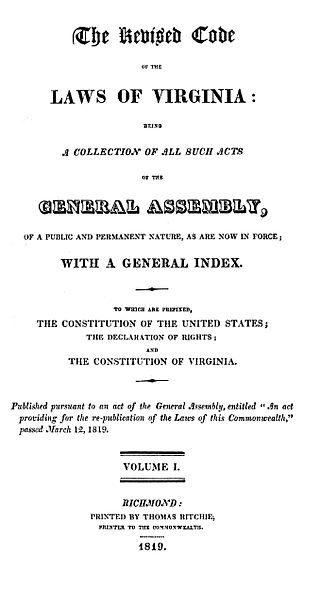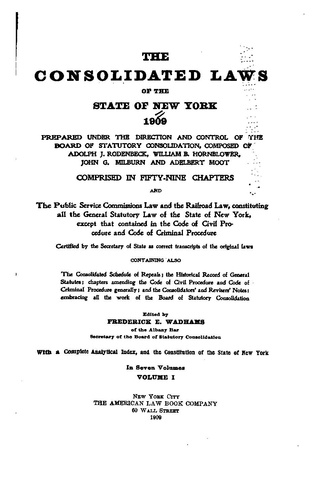Related Research Articles
Promulgation is the formal proclamation or the declaration that a new statutory or administrative law is enacted after its final approval. In some jurisdictions, this additional step is necessary before the law can take effect.

The Florida Legislature is the legislature of the U.S. state of Florida. It is organized as a bicameral body composed of an upper chamber, the Senate, and a lower chamber, the House of Representatives. Article III, Section 1 of the Florida Constitution, adopted in 1968, defines the role of the legislature and how it is to be constituted. The legislature is composed of 160 state legislators. The primary purpose of the legislature is to enact new laws and amend or repeal existing laws. It meets in the Florida State Capitol building in Tallahassee.

The Florida House of Representatives is the lower house of the Florida Legislature, the state legislature of the U.S. state of Florida, the Florida Senate being the upper house. Article III, Section 1 of the Constitution of Florida, adopted in 1968, defines the role of the Legislature and how it is to be constituted. The House is composed of 120 members, each elected from a single-member district with a population of approximately 180,000 residents. Legislative districts are drawn on the basis of population figures, provided by the federal decennial census. Representatives' terms begin immediately upon their election.

Proposition 59 was an amendment of the Constitution of California that introduced freedom of information or "sunshine" provisions. It was proposed by the California Legislature and overwhelmingly approved by the voters in an initiative held as part of the November 2004 elections.
The Massachusetts General Laws is a codification of many of the statutes of the Commonwealth of Massachusetts. The Commonwealth's laws are promulgated by an elected bicameral ("two-chamber") legislative body, the Massachusetts General Court. The resulting laws—both Session Laws and General Laws—together make up the statutory law of the Commonwealth.

The Florida Senate is the upper house of the Florida Legislature, the state legislature of the U.S. state of Florida, the Florida House of Representatives being the lower house. Article III, Section 1 of the Constitution of Florida, adopted in 1968, defines the role of the Legislature and how it is to be constituted. The Senate is composed of 40 members, each elected from a single-member district with a population of approximately 540,000 residents. Legislative districts are drawn on the basis of population figures, provided by the federal decennial census. Senators' terms begin immediately upon their election. The Senate Chamber is located in the State Capitol building.

The government of Florida is established and operated according to the Constitution of Florida and is composed of three branches of government: the executive branch consisting of the governor of Florida and the other elected and appointed constitutional officers; the legislative branch, the Florida Legislature, consisting of the Senate and House; and the judicial branch consisting of the Supreme Court of Florida and lower courts. The state also allows direct participation of the electorate by initiative, referendum, and ratification.

The Code of Virginia is the statutory law of the U.S. state of Virginia and consists of the codified legislation of the Virginia General Assembly. The 1950 Code of Virginia is the revision currently in force. The previous official versions were the Codes of 1819, 1849, 1887, and 1919, though other compilations had been printed privately as early as 1733, and other editions have been issued that were not designated full revisions of the code.

The government of Texas operates under the Constitution of Texas and consists of a unitary democratic state government operating under a presidential system that uses the Dillon Rule, as well as governments at the county and municipal levels.

The California Codes are 29 legal codes enacted by the California State Legislature, which, alongside uncodified acts, form the general statutory law of California. The official Codes are maintained by the California Office of Legislative Counsel for the Legislature. The Legislative Counsel also publishes the official text of the Codes publicly at leginfo.legislature.ca.gov.

The law of California consists of several levels, including constitutional, statutory, and regulatory law, as well as case law. The California Codes form the general statutory law, and most state agency regulations are available in the California Code of Regulations.
The law of Florida consists of several levels, including constitutional, statutory, and regulatory law, as well as case law and local law. The Florida Statutes form the general statutory law of Florida.

The Annotated Code of Maryland, published by The Michie Company, is the official codification of the statutory laws of Maryland. It is organized into 36 named articles. The previous code, organized into numbered articles, has been repealed.

The law of the United States comprises many levels of codified and uncodified forms of law, of which the most important is the nation's Constitution, which prescribes the foundation of the federal government of the United States, as well as various civil liberties. The Constitution sets out the boundaries of federal law, which consists of Acts of Congress, treaties ratified by the Senate, regulations promulgated by the executive branch, and case law originating from the federal judiciary. The United States Code is the official compilation and codification of general and permanent federal statutory law.
The law of Virginia consists of several levels of legal rules, including constitutional, statutory, regulatory, case law, and local laws. The Code of Virginia contains the codified legislation that define the general statutory laws for the Commonwealth.

The law of New York consists of several levels, including constitutional, statutory, regulatory and case law, and also includes local laws, ordinances, and regulations. The Consolidated Laws form the general statutory law.
The law of Texas is derived from the Constitution of Texas and consists of several levels, including constitutional, statutory, regulatory law, as well as case law and local laws and regulations.

The law of Michigan consists of several levels, including constitutional, statutory, regulatory and case law. The Michigan Compiled Laws form the general statutory law.
The law of Washington consists of several levels, including constitutional, statutory, regulatory and case law, as well as local ordinances. The Revised Code of Washington forms the general statutory law.

The Consolidated Laws of the State of New York are the codification of the permanent laws of a general nature of New York enacted by the New York State Legislature.
References
- 1 2 3 4 5 6 Florida Style Manual (PDF) (7th ed.). Florida State University Law Review. pp. 25–40.
- ↑ See Florida Statutes (2015) at vi (Preface).